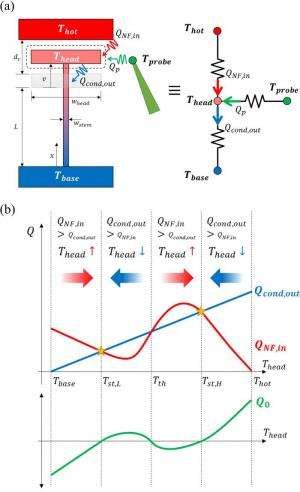January 7, 2015 feature
Thermal memory thrives at extremely high temperatures

(Phys.org)—While the performance of electronic memory devices degrades at high temperatures, a newly proposed memory actually requires temperatures in excess of 600 K to operate. Called NanoThermoMechanical memory, the new device uses heat instead of electricity to record, store, and recover data. With its ability to operate at extremely high temperatures, the memory could be used in space exploration missions, deep-well drilling, and in combustion engines, among other applications.
The researchers, graduate student Mahmoud Elzouka and Assistant Professor Sidy Ndao at the University of Nebraska-Lincoln, have published a paper on the NanoThermoMechanical memory in a recent issue of Applied Physics Letters.
"The important significance is the actual design/development of a practical, high-temperature memory (and logic) device," Ndao told Phys.org. "Currently, nothing exists that can fulfill data recording or random access memories that can function well in extreme environments."
In the proposed NanoThermoMechanical memory, the two binary memory states "0" and "1" are represented by two stable temperature states. In simulations, for example, a temperature of 1038 K represents "0" while 1341 K represents "1."
Having two distinct stable temperature states is unusual, as most devices have only one such state. The key to achieving two stable states involves careful engineering to control the heat transfer between two closely spaced bodies.
In the proposed set-up, the two closely spaced bodies are a hot fixed top terminal and an unfixed colder head just beneath it. The head is free to move up and down, and is connected by a stem to a bottom fixed "cold" (600 K in simulations) terminal. When heat is applied to the hot terminal, some of the heat is transferred to the head by far-field thermal radiation. As the temperature of the head increases, the stem elongates due to thermal expansion, so the head moves even closer to the hot terminal.
As the temperature of the head increases, the separation distance between the hot terminal and the head becomes so small (on the order of one wavelength of radiation) that near-field rather than far-field thermal radiation becomes the dominant method of heat transfer. Importantly, heat transfer from the hot terminal to the colder head now actually increases, even though the temperature difference between the terminal and the head decreases. This somewhat counterintuitive phenomenon, called negative differential thermal resistance (NDTR), is what enables the existence of two stable temperature states.
As shown in the figure above, each of the two stable temperature states occurs when the heat supplied to the head by the hot terminal (via near-field radiation) is equal to the heat lost from the head (via conduction down the stem). These two stable states, also called thermal latching states, are represented by yellow stars in the figure. If a stable state is perturbed by a decrease in temperature, it automatically returns to the stable state by gaining heat; if perturbed by an increase in temperature, it returns to the stable state by losing heat. About halfway in between the two stable states is a critical state, above which the system moves to the higher stable temperature state, and below which it moves to the lower stable temperature state.
By using a thermal probe to control the temperature of the hot terminal, data can be written and stored in the memory. The data can later be read out by measuring the temperature of an insulated probe.
In the future, the NanoThermoMechanical memory could also be used as a logic device, also with the advantage of operating in high-temperature environments. The next steps include experimentally realizing the memory design.
"We are currently in the process of fabricating a working prototype of the near-field NanoThermoMechanical memory," Ndao said.
More information: Mahmoud Elzouka and Sidy Ndao. "Near-field NanoThermoMechanical memory." Applied Physics Letters. DOI: 10.1063/1.4904828
Journal information: Applied Physics Letters
© 2015 Phys.org


















